This is a variation of a more common layered salad of tomatoes, basil, and Mozzarella cheese, "Insalata Caprese". In this version, I finely chop onion or shallot and mix in a good quality olive oil, salt, black pepper and dash of balsamic vinegar and dress cubes of mozzarella cheese and quarters of tomatoes (skin removed, either by peeling the skin with a knife as I did here or blanching very briefly) and garnish with chiffonade of fresh basil. Key to this dish is good quality ingredients including the olive oil and balsamic vinegar.
Tuesday, December 1, 2009
Tomato and Mozzarella cheese salad トマトとマッツレラチーズのサラダ
This is a variation of a more common layered salad of tomatoes, basil, and Mozzarella cheese, "Insalata Caprese". In this version, I finely chop onion or shallot and mix in a good quality olive oil, salt, black pepper and dash of balsamic vinegar and dress cubes of mozzarella cheese and quarters of tomatoes (skin removed, either by peeling the skin with a knife as I did here or blanching very briefly) and garnish with chiffonade of fresh basil. Key to this dish is good quality ingredients including the olive oil and balsamic vinegar.
Monday, November 30, 2009
Scallop sashimi three ways ホタテ貝の刺身
We can not easily get "sashimi" grade scallops. I make a scallop sashimi-like dish from regular frozen and thawed scallops from a nearby gourmet market by poaching the scallops in a dashi broth and sake mixture gently for 5 minutes until the scallops just become opaque throughout. I chill the scallops and serve with a pickled plum "bainiku" 梅肉 sauce like sashimi. This is not bad but does not have the texture and sweetness of the real thing. Fortunately, we got sashimi-grade sea scallops from Catalina Offshore Products along with other goodies. The only problem was that we had to eat them fairly quickly. Since we had guests who appreciate scallop sashimi, I made three different scallop sashimis.
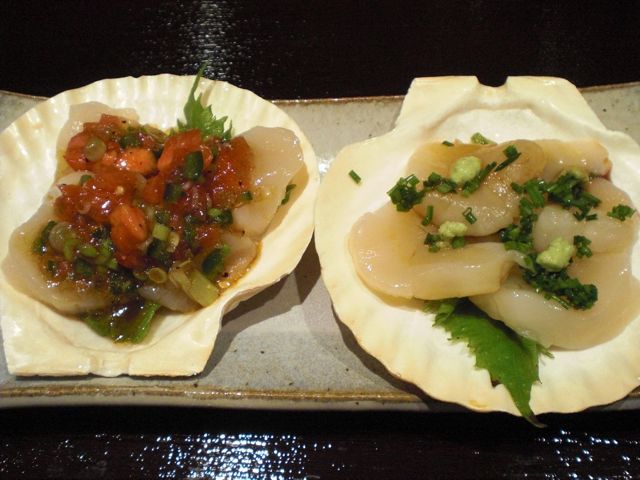 I washed the scallops and patted them dry. I removed the small hard muscle attached to the side of the scallops. I sliced one large scallop into 4-5 thin rounds. I salted them very lightly and squeezed lemon over them. The verions shown in the picture are: 1. Straight forward sashimi (upper right) with real grated wasabi (see below) and soy sauce, 2. scallops with salsa sauce (upper left), and 3. Scallops with pickled plum sauce ("bainiku" 梅肉) (below). Garnishes are lemon sclices, chopped chives and perilla leaves.
I washed the scallops and patted them dry. I removed the small hard muscle attached to the side of the scallops. I sliced one large scallop into 4-5 thin rounds. I salted them very lightly and squeezed lemon over them. The verions shown in the picture are: 1. Straight forward sashimi (upper right) with real grated wasabi (see below) and soy sauce, 2. scallops with salsa sauce (upper left), and 3. Scallops with pickled plum sauce ("bainiku" 梅肉) (below). Garnishes are lemon sclices, chopped chives and perilla leaves.
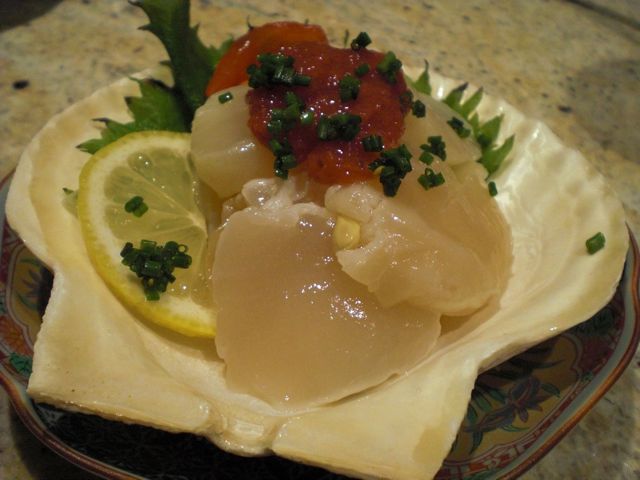
For the salsa sauce: Chop tomatoes, shallots, Jalapeno peper (seeded and de-veined) finely and add olive oil, lemon or lime juice, salt and pepper. Pour over the scallop. Sometimes I also use balsamic vinegar and soy sauce (no lemon juice in that case).
 Regrading "wasabi" 山葵; I mentioned a bit about this in the previous post. There are two companies which sell "real" wasabi"; one is called "Real Wasabi" another is called "Pacific Farm". You could buy; 1. wasabi daikon 山葵大根 or rhizomes, 2. frozen grated real wasabi in a tube, or 3. wasabi powders made from real wasabi not from western horseradish. Last time we tried rhizomes from Real Wasabi. This time I tried "the grated frozen real wasabi in a tube from Pacific Farm" (left image). I think this is very good and probably more cost effective than buying a wasabi rhizome, although it has some additives like artificial coloring. The other problem is packaging. Initially, the water and wasabi appeared to seperate and then it becomes difficult to squeeze out from the tube but the flavor and heat are very similar to the freshly grated wasabi. It is probably best to smear a small dab on the sashimi itself before dipping in soy sauce but this may be bit too strong for some. In that case, dissolve wasabi in soy sauce. It will keep a long time frozen and, reportedly, for 30 days after opening the tube. In my experience, however, at 3 weeks after opening, the remaining wasabi (about 1/8 of the tube) became almost impossible to squeeze out. By cutting open the tube, I found that the wasabi became bit dry and chalky in texture. The flavor was still there, though. Some of sushi bars in Washington, DC started offering "real" wasabi with an extra charge but I think it is worth it.
Regrading "wasabi" 山葵; I mentioned a bit about this in the previous post. There are two companies which sell "real" wasabi"; one is called "Real Wasabi" another is called "Pacific Farm". You could buy; 1. wasabi daikon 山葵大根 or rhizomes, 2. frozen grated real wasabi in a tube, or 3. wasabi powders made from real wasabi not from western horseradish. Last time we tried rhizomes from Real Wasabi. This time I tried "the grated frozen real wasabi in a tube from Pacific Farm" (left image). I think this is very good and probably more cost effective than buying a wasabi rhizome, although it has some additives like artificial coloring. The other problem is packaging. Initially, the water and wasabi appeared to seperate and then it becomes difficult to squeeze out from the tube but the flavor and heat are very similar to the freshly grated wasabi. It is probably best to smear a small dab on the sashimi itself before dipping in soy sauce but this may be bit too strong for some. In that case, dissolve wasabi in soy sauce. It will keep a long time frozen and, reportedly, for 30 days after opening the tube. In my experience, however, at 3 weeks after opening, the remaining wasabi (about 1/8 of the tube) became almost impossible to squeeze out. By cutting open the tube, I found that the wasabi became bit dry and chalky in texture. The flavor was still there, though. Some of sushi bars in Washington, DC started offering "real" wasabi with an extra charge but I think it is worth it.
For the bainiku sauce: Remove the meat from "umeboshi: chop it finely and mix in a small amount of mirin and rice vinegar. Pour over the scallop.
Friday, November 27, 2009
Potatoe gratiné square with asparagus ポテトグラタン、アスパラ添え
My wife made this potato gratin dish (I helped with cutting potatoes and making the Béchamel sauce) as a side when we made a roasted pork tenderloin with mustard, ginger, and garlic marinade. The original recipe for the potato dish is from "Cooking light" but I do not think this is quite "light" cooking. I just used the leftover potato gratin as a part of Izakaya course menu item.
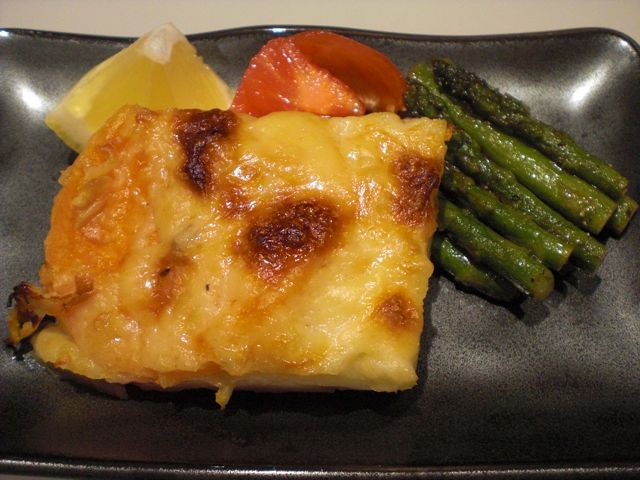
For the potato gratin, peel and slice both potatoes and sweet potatoes (2 medium, each) in 1/4 inch in thickness. Boil 4-5 minutes in salted water until just cooked. For Béchamel sauce, saute one strip of bacon finely cut until the fat is rendered and the bacon gets crispy. Take out the bacon and set aside. Add 1 tbs of butter and saute chopped onion (one medium) for 1-2 minutes (do not brown) and add 1/3 cup of all purpose flour. Keep sauteing so that all the onion pieces are coated with flour (using finely chopped onion is the secret of making Béchamel with a small amount of fat since each piece of onion holds flour on its surface and prevents the flour from clumping). Add 2 cups of low-fat (I used 1%) milk at once and stir on medium low heat. Add back the bacon. As the liquid heats up, it thickens. Add more milk if it is too thick. Stir in 1/2 cup of grated Parmigiano-Reggiano cheese and adjust the seasoning (salt and pepper). The final product should be rather loose (if needed, add more milk). Grease a rectangular (9x13 inch) pyrex baking dish with light olive oil. Make alterate layers of the cooked potatoes and sweet potatoes slices and pour the Béchamel cheese (Mornay) sauce over the potatoes to cover. Bake at 370F for 45 minutes.
For this serving, cut small squares of the leftover potato gratin and put it in toaster oven at 400F for 5 minutes or until throughly heated. Saute green asparagus (pre boiled) in browned melted butter and season (salt and pepper). We used this as a part of the Izakaya course for our guests. Although this is not Japanese dish it went very well with the rest of the Japanese dishes we served. Such a comfort food.
Thursday, November 26, 2009
Gyoza pork dumpling 餃子 and Celery salad セロリの昆布茶サラダ
Gyoza 餃子 (known in the U.S. as "Pot sticker") is a very popular Sino-Japanese dish and certainly a regular or "teiban" 定番 dish in any Izakaya. Any culture seems to have some kind of "dumpling" dish which is typically a homey comfort food and gyoza belongs in this category. I understand that there is a significant difference between gyoza and "wonton" 雲呑 in the original Chinese dish but most Japanese, including myself, appear to consider both dishes as variations of "gyoza". As usual, there are Japanese modifications and variations to this dish transforming it into a Japanese dish distinct from the original Chinese.
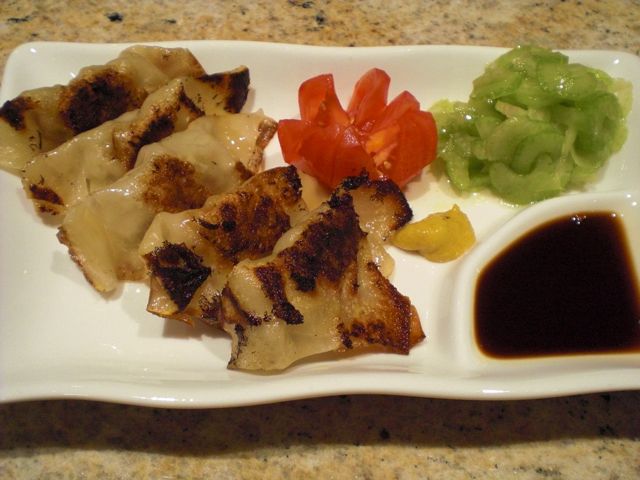
The skin or casing is made of wheat flour and water and it can be thick, thin, round, or square. There are also several different ways to form and seal the dumplings. Fillings for gyoza can be shrimp, meat (mostly pork) which are mixed with finely diced vegetables or all vegetables or even tofu. Gyoza can be cooked in, at least, 4 different ways, 1. combined pan-fried/steamed, 2. deep fried, 3. cooked in soup, and 4. steamed. In addition, you may have many choices for dipping sauces. So the combination of these factros can create quite a large variation in gyoza. Some locales in Japan have made "gyoza" as their local specialities. For example, Utusnomiya 宇都宮 is famous for the local versions of gyoza and even has an annual gyoza festival. We tried Utsunomiya gyozas in the past but we were not too impressed, which may have been due to our poor choice of restaurant.
I served this with a celery salad. We had this celery salad for the first time in Kurashiki 倉敷 in south western mainland Japan, when we went to a smoke-filled small hole-in-the-wall drinking place just across from the train station. Thinly sliced celery was simply dressed with powered kelp tea or "kobucha" 昆布茶 instead of using salt.I also add a very small amount of olive oil.
In any case, this is my version of a pork gyoza which is probably very similar to what my mother made and it is also similar to the ones we had in a Izakanya in Japan last time. The skin or casing available in a regular grocery store in the U.S. is called "Wonton" skin and is rather thin and square as opposed to a Japanese version which is round (you could buy them at a Japanese grocery store frozen). I do not see much difference except for the cosmetic appearance and am happy with the American version of "wontan" skins for my gyoza.
For a filling, I use pork (usually the trimmings of the pork tenderloin which I hand chop). I mix the pork with finely chopped precooked cabbage leaves, grated ginger root, finely chopped garlic and scallion with a dash of dark sesame oil, soy sauce, mirin, cracked black pepper and salt. I also sometimes add finely chopped shiitake mushroom. (Unfortunately I usually "eyeball" all the ingredients but the proportion of vegetable and meat can be varied). I try not to over season since it is eaten with an additional dipping sauce and Japanese hot mustard. Knead or mix the meat mixture well.
To form the gyoza, take one sheet of the wanton skin in your left palm (I am right handed) and wet two neighboring edges with water using your finger tip. Put scant 1 tsp of the filling in the center and fold to make a triangle so that the two wet edges are pressed against the two dry edges. Try to squeeze out any trapped air around the filling and press the edges to seal. Using your right thumb and index finger pinch and make several crimps along the sealed edges. You should assemble the gyoza just before cooking otherwise the skin will get wet and sticky.
Place the gyoza in a large enough non-stick frying pan (large enough so that gyoza can be placed in one layer comfortably) on medium high heat. Add 1tbs of peanut oil and a splash of dark sesame oil. When oil is hot add gyoza in one layer without touching each other one at a time. When one side is browned (1-2 minutes) turn them over to brown the other side (This is not the traditional way of doing this. Traditionally, the gyoza are placed together to make a neatly arranged circle to fill the pan and only one side is browned. After cooking is completed, they are inverted on a serving plate en mass but I like to brown both sides). Then add 1/3 cup of hot water into the pan (be careful, it will boil and steam immediately) and put a tight lid on. Steam will come out from the edge of the lid or steam hole if your lid has one. (I sometimes have to put the measuring cup on the lid to hold the lid down against the force of the steam). Cook for about 5 minutes or until the amount of steam decreases. Open the lid and the water should be almost all gone. Make sure all the water is gone and the bottom becomes brown and crispy again. For dipping sauce, I make a traditional mixture of rice vinegar and soy sauce (half and half) with Japanese hot mustard.
I served this with a celery salad. We had this celery salad for the first time in Kurashiki 倉敷 in south western mainland Japan, when we went to a smoke-filled small hole-in-the-wall drinking place just across from the train station. Thinly sliced celery was simply dressed with powered kelp tea or "kobucha" 昆布茶 instead of using salt.I also add a very small amount of olive oil.
Wednesday, November 25, 2009
Sea urchin and scrambled egg with lobster sauce 雲丹とスクランブルエッグ
Based on Scrambled eggs with sea urchin and lobster sauce 雲丹のスクランブルエッグ オーマルロブスターソース (Mark's book p148)
For the scrambled egg, I used one egg (for two small servigs you see here) and 2-3 tsp of cream with salt and pepper. I melted butter in a small non-stick frying pan on low heat and vigorously stirred using a silicon spatula until a creamy texture was reached but I did not further cook or set the egg as suggested in the recipe since I wanted a soft creamy texture matching that of the sea urchin. I placed this creamy egg in the egg-shaped glass containers and placed uni in the center. I then drizzled the sauce around the perimeter. I did not have chervil so I garnished it with parsley. For one version I browned the uni with a kitchen torch before placing it on the egg as suggested in the recipe (image above on the right and image below) and, for another, I did not (image above on the left) to compare.
 We think browning the uni may add some interesting flavors but, for this dish, it did not make a big difference (although it may give a nice visual effect). The sauce went well (surprisingly), with the lobster flavor and saltiness from the anchovy. But again, we have no idea if this is even close to the original recipe. The egg was very creamy matching the texture of the uni and the proportion of the egg and uni was perfect. So, as a dish, the way I made it, it was a success of sorts. Above all, the containers were perfect!
We think browning the uni may add some interesting flavors but, for this dish, it did not make a big difference (although it may give a nice visual effect). The sauce went well (surprisingly), with the lobster flavor and saltiness from the anchovy. But again, we have no idea if this is even close to the original recipe. The egg was very creamy matching the texture of the uni and the proportion of the egg and uni was perfect. So, as a dish, the way I made it, it was a success of sorts. Above all, the containers were perfect!
This one is from Mark's book p148. We usually do not want to "cook" good sea urchin, but this recipe looked so interesting we had to try it. Again, I have to start by saying I did not (or could not) follow the recipe precisely. First, we did not want to eat too much egg with uni, second, we did not have a lobster head to make the sauce. I will have to remake the sauce sometime in the future but having a dinner with both lobster and uni coinsiding may not be easy. Maybe I can make the lobster-tomato sauce first and freeze it. So, this time, instead, I used a "gourmet" canned lobster bisque (whenever we have lobster at home, I make lobster bisque from the lobster carcass). Compared to my bisque, this supposedly "gourmet" canned bisque was not really good as a soup but, at least, it had lobster and tomato flavors. I am sure the tomato flavor is from tomato paste. I added a small amount of finely chopped fresh tomato and reduced the bisque a bit, and added a splash of Fino sherry to liven up the taste. I mixed a portion of this with a small amount of smashed anchovy filet off heat until the saltiness was appropriate. I have no idea if this "sauce" is even similar to the original in the recipe.
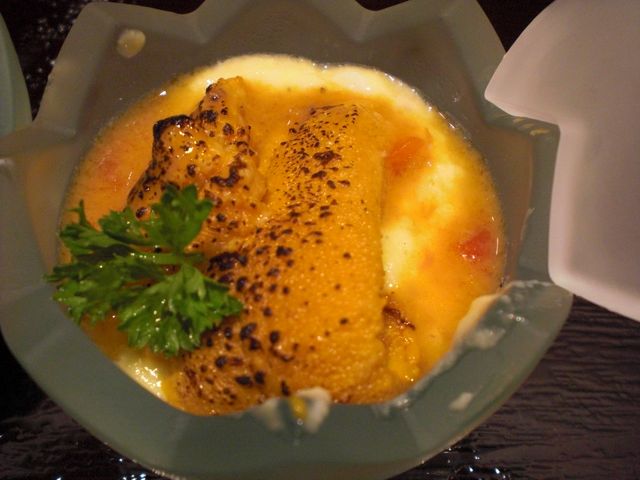
The egg-shaped glass containers (slightly larger than real eggs) were reportedly used by a Michelin 3 star chef in Virginia, Patrick O'Connell of Inn at Little Washington. He served soft scrambled egg and asparagus tips as a brunch menu to the Queen of England when she was visiting Virginia several years ago. (We do not know if indeed Queen tasted this dish). We saw the recipe and the egg shaped container in a Washington post article. The dish sounded interesting so I ordered the container from Korin and tried to reproduce the recipe. (BTW Korin no longer carries this item).
Last time we were at the Inn at Little Washington, they had this scrambled egg dish as an appetizer and my wife ordered it. It came in the same egg-shaped container you see here but my wife was not too impressed citing that the eggs were bit overcooked. She then observed that the version I made was more creamy!
Tuesday, November 24, 2009
Sea urchin sashimi and donburi 雲丹の刺身と雲丹丼
We cannot decide if we like ankimo 鮟肝 better than sea urchin "uni" 雲丹 or vice-versa. But the batch of California sea urchin we got this time was particularly excellent. Certainly much better than most we tasted in Japan last time. This one was harvested offshore in California and delivered to us overnight by Catalonia Offshore Products. We can get uni from California and from Maine in the U.S. Maine uni is like "bafun uni" 馬糞雲丹. It is smaller, firmer, darker, and gamier. We prefer the one from California which is bright yellow with a very creamy texture and clean taste. We enjoy either uni as long as it is fresh and not off-tasting. We gave up ordering uni in sushi bars since the variability of uni quality and freshness is so wide and even after asking the sushi chef if the uni is good and getting his approval, we have had less-than-aceptable uni. Having bad uni turns you off eating any uni very quickly.
Sunday, November 22, 2009
Monk fish liver "ankimo" 鮟肝
Monk fish liver "ankimo" with orange marmalade sauce 鮟肝のオレンジママレイドソース
Monkfish liver "ankimo" あんきも鮟肝 is one of our top favorite delicacies. We think the best we had was at "Tako Grill". Chef Kudo prepares a monkfish liver in house (he said it was steamed) without making it to a regular cylinder shape. It is so delicate and tasty, when they offer "ankimo" at Tako Grill, we order it without fail. Ankimo is often equated to foie gras. Actually, we like ankimo better than foie gras. The one shown here is a commercial cylindrical-shaped frozen one which came from Catalina Offshore Products (originated in Japan). It is not as delicate in texture as Chef Kudo's but it is quite good.
Ankimo is usually served with "ponzu" (more accurately "ponzu-shoyu" sauce) and grated daikon with red pepper (momiji oroshi) もみじおろし. For a change, we made our version of the Chef Kudo's sauce which he serves with ankimo at Tako Grill. We like this sauce because it has a lovely orange flavor that goes well with the ankimo. Although we did not ask for the recipe, my wife figured that it was made of orange marmalade and soy sauce (She has a very discriminating palate, for sure, better than mine). I experimented with the ratio and found that close to 4:1 ratio of marmalade to soy sauce appears to work best and closely emulates the sauce we had at the restaurant (it was a surprise that we had to use that much marmalade, I started with 1:1 and soy sauce and the taste was too strong, salty with no orange flavor). Initially I heated up the mixture but marmalade dissolves nicely without heat and appears to retain the orange flavor better. I suggest to just keep adding the marmalade to soy sauce until the desired sweetness and orange flavor is reached. One disclaimer; we do not know how Chef Kudo really makes this sauce. So this recipe may be totally different from his, although it tastes similar to us. This may go well with a red wine such as Rhone or Shiraz from Australia since it does not have strong acidity but we had this with cold sake.
Monkfish liver "ankimo" あんきも鮟肝 is one of our top favorite delicacies. We think the best we had was at "Tako Grill". Chef Kudo prepares a monkfish liver in house (he said it was steamed) without making it to a regular cylinder shape. It is so delicate and tasty, when they offer "ankimo" at Tako Grill, we order it without fail. Ankimo is often equated to foie gras. Actually, we like ankimo better than foie gras. The one shown here is a commercial cylindrical-shaped frozen one which came from Catalina Offshore Products (originated in Japan). It is not as delicate in texture as Chef Kudo's but it is quite good.
Ankimo is usually served with "ponzu" (more accurately "ponzu-shoyu" sauce) and grated daikon with red pepper (momiji oroshi) もみじおろし. For a change, we made our version of the Chef Kudo's sauce which he serves with ankimo at Tako Grill. We like this sauce because it has a lovely orange flavor that goes well with the ankimo. Although we did not ask for the recipe, my wife figured that it was made of orange marmalade and soy sauce (She has a very discriminating palate, for sure, better than mine). I experimented with the ratio and found that close to 4:1 ratio of marmalade to soy sauce appears to work best and closely emulates the sauce we had at the restaurant (it was a surprise that we had to use that much marmalade, I started with 1:1 and soy sauce and the taste was too strong, salty with no orange flavor). Initially I heated up the mixture but marmalade dissolves nicely without heat and appears to retain the orange flavor better. I suggest to just keep adding the marmalade to soy sauce until the desired sweetness and orange flavor is reached. One disclaimer; we do not know how Chef Kudo really makes this sauce. So this recipe may be totally different from his, although it tastes similar to us. This may go well with a red wine such as Rhone or Shiraz from Australia since it does not have strong acidity but we had this with cold sake.
Subscribe to:
Posts (Atom)

